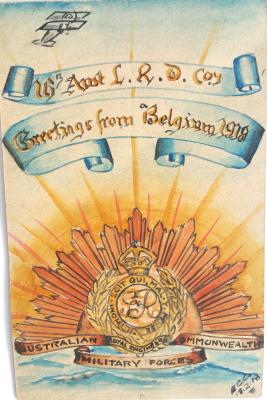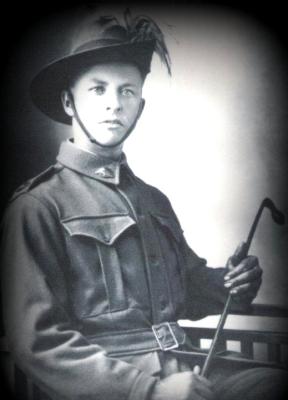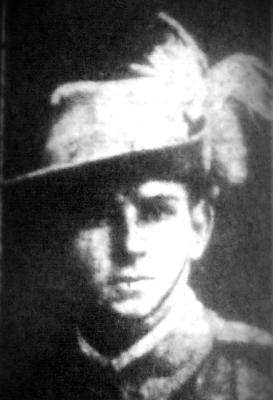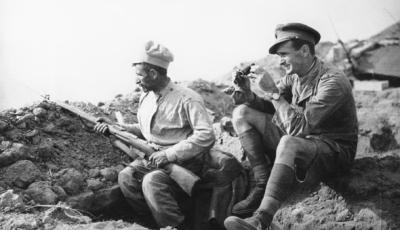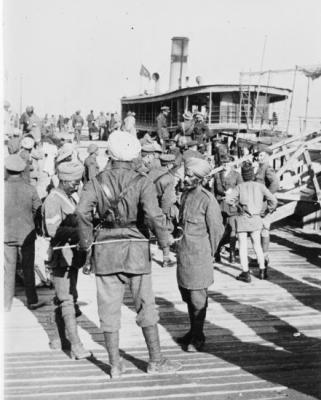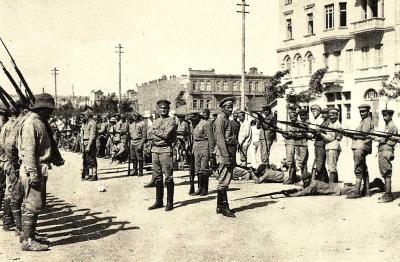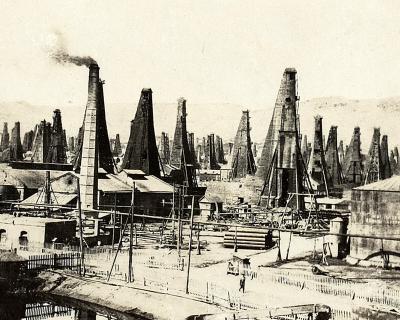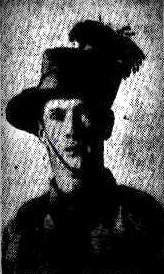Railway Operating Division - World War 1, Postcard, GARBETT, 1917
Postcard sized watercolour with main motif being map of Australia superimposed on stylised Union Jack. Shoulder flash of 16 Australian Light Rail Operating Company in upper right.. The illustration shows the completed Trans Australian link across the Nullabor and also South Australia still inclusive of Northern Territory.
Edwin Charles Garbett was born in Melbourne, Victoria on 15 March 1889. He came to Western Australia by cattle ship in 1897 and moved around the southwest and attended many different schools before settling in Midland in 1904. He attended Chidlow Wells School and in 1907 he won a Midland Junction Technical Education scholarship in mechanical drawing, forming part of his apprenticeship in diesel engineering with the WA Government Railways Workshop in Midland.
After Edwin completed his apprenticeship, he moved to Sydney to work on ships, before sailing on a steamer to England. Edwin documented this trip in detail, drawing the workings of the ship’s engine in pencil on various scraps of paper. On arrival in England, he found work as a fitter with a railway company and again, describes their locomotives, illustrating them and recording information.
Edwin returned to Western Australia and continued his work as a fitter at the Midland Railway Workshops before enlisting with the 2nd Light Railway Company on 24 March 1917, his service number was 1909. Edwin undertook further training as a blacksmith and fitter at Broadmeadows in Melbourne before sailing aboard the “Ascanius” in May 1917. He was stationed at St Lucia Barracks, Borden in Hampshire and promoted to 2nd Corporal where he was paid 8/- per day as a fitter. He sailed from Southampton to France in September 1917.
Edwin sent postcards home, stating he was “somewhere in Belgium” in 1917 and from December 1918 until February 1919, he was stationed at Courtrai near the French border with 2nd Australian Light Railway Operating Company. After the Armistice, Edwin was granted leave from June to August 1919 to do a design course at A.H Clarkson Ltd, advertising specialists located in Fleet Street, London. Following this, he returned to Western Australia and his job at the Midland Workshops. Edwin died, aged 42, in 1932, from pneumonia and pleurisy.
Details
Details
Initialed ECG and dated 6-12-17. Inscribed: Greetings from 16 ALRAC Somewhere in Belgium 1917
The Railway Operating Division (ROD) was a division of the Royal Engineers formed in 1915 to operate railways in the many theatres of the war. It was largely composed of railway employees and operated both standard gauge and narrow gauge railways. The ROD operated their first line on a section of the Hazebrouck–Ypres line.
The ROD requisitioned many diverse locomotives from Britain's railway companies and leased several Belgian locomotives sent to France in 1914, but as the war dragged on adopted the Great Central Railway's Robinson Class 8K 2-8-0 as its standard freight locomotive to become the ROD 2-8-0. Some locomotives were also purchased from Baldwin in the United States. They also operated narrow-gauge engines (600 millimetres (2.0 ft) gauge trains).
Australian Imperial Force units within the Railway Operating Division were
Headquarters Australian Railway Group
1st Light Railway Operating Company
2nd Light Railway Operating Company
3rd Light Railway Operating Company
4th Broad Gauge Railway Operating Company
5th Broad Gauge Railway Operating Company
6th Broad Gauge Railway Operating Company
Australian Army Museum of Western Australia
Australian Army Museum of Western Australia
More items like this
Other items from Australian Army Museum of Western Australia
- World War 1, Australia, Western Australia, 143 WHITE, 10 Light Horse
- Railway Operating Division - Postcard, GARBETT, 1918
- World War 1, Australia, Western Australia, 142 COBB, 10 Light Horse
- World War 1, Australia, Western Australia, 141 KIRSCH, 10 Light Horse
- World War 1, Australia, Western Australia, 140 PLANT, 10 Light Horse
- World War 1, Dunsterforce, Caucasus, LLOYD, 1917
- World War 1, Dunsterforce, Caucasus,1917
- World War 1, Dunsterforce, Mesopotamia, Basra, 1918
- World War 1, Dunsterforce, Caucasus, Baku, 1918
- World War 1, Dunsterforce, Caucasus, Baku, 1917
- Starting Cannon - America's Cup Defence, Fremantle,1986/87
- World War 1, Australia, Western Australia, 139 CUMMING, 10 Light Horse
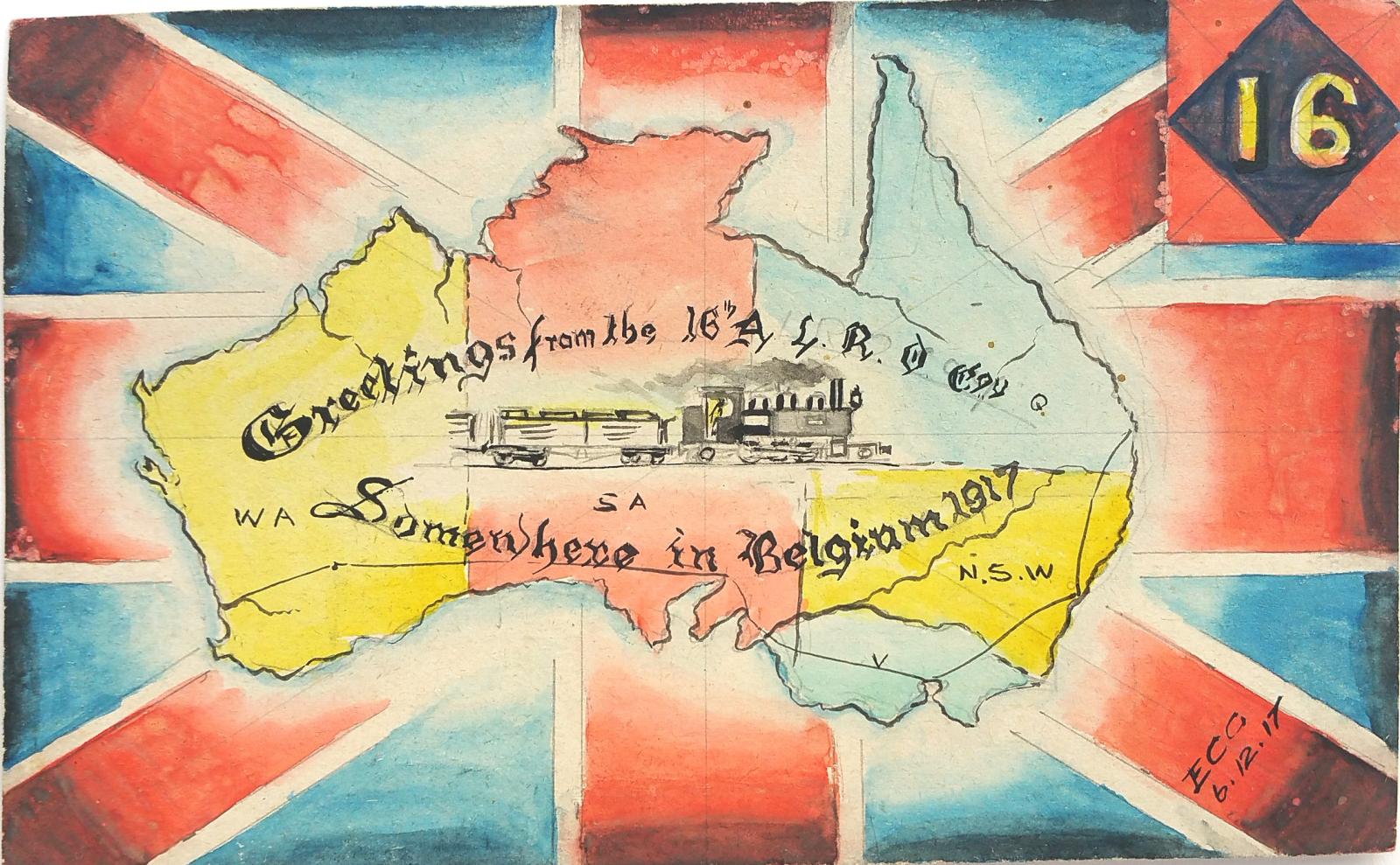
Scan this QR code to open this page on your phone ->



